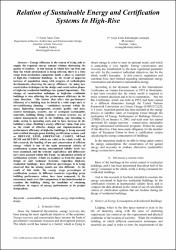| dc.contributor.author | Ürük, Zerrin Funda | |
| dc.contributor.author | Külünkoğlu İslamoğlu, Asiye Kübra | |
| dc.date.accessioned | 2019-06-20T20:20:20Z | |
| dc.date.available | 2019-06-20T20:20:20Z | |
| dc.date.issued | 2018 | en_US |
| dc.identifier.isbn | 978-1-5386-4184-2 | |
| dc.identifier.uri | https://hdl.handle.net/11363/1313 | |
| dc.description.abstract | Energy efficiency is the system of being able to supply the required energy amount without decreasing the quality of comfort. In this system, in which first our lives and then the whole environment is being affected, there is a wide range from mechanical equipment inside a place to construct of high-rise residential buildings. As the result of apparent increase of population along with progress of technological developments, observing the energy efficiency - by using new construction techniques in the design and construction phases of high-rise residential buildings-has gained importance. The change of construction technique at high-rise residential buildings is also affecting the performance efficiency in the same direction. The factors that affect the performance efficiency of a building may be listed in a wide scope such as air-conditioning (heating - ventilation) systems within the space, lightening management, acoustic quality and noise control techniques, security, use of ecological (sustainable) materials, building fitting (sanitary system) systems, use of central management unit in the building, and intending to make saving in operating costs and to have increase in the building's value. Building's energy efficiency value, that arise as the result of effective design and implementation of performance efficiency at high-rise buildings, is being assessed and certified through green building certification systems such as BREEAM, LEED, GREENSTAR, CASBEE, SBTool, DGNB and BEP-BUY which are valid in the whole world. In this research, the heading of use and conservation of efficient energy - which is one of the main assessment criteria of certification systems having international validity level-has been examined, and the systems' equivalence and differences have been assessed within this frame. As calculation criteria of certification systems - which are loadstar as from the phase of design of and technical decisions regarding high-rise residential buildings-have different percentages, it is being observed that the arising results are also different. As the result of this study, the energy usage percentages of certification systems in different countries regarding green building performance values have been compared. In the assessment made over this comparison, it has been intended to examine the building - being the candidate of obtaining certificate-in respect of energy performance at its project design phase. | en_US |
| dc.language.iso | eng | en_US |
| dc.publisher | IEEE, 345 E 47TH ST, NEW YORK, NY 10017 USA | en_US |
| dc.rights | info:eu-repo/semantics/openAccess | en_US |
| dc.rights | Attribution-NonCommercial-NoDerivs 3.0 United States | * |
| dc.rights.uri | http://creativecommons.org/licenses/by-nc-nd/3.0/us/ | * |
| dc.subject | Sustainability | en_US |
| dc.subject | Green-building | en_US |
| dc.subject | Energy | en_US |
| dc.subject | High-building | en_US |
| dc.subject | Design | en_US |
| dc.title | Relation of Sustainable Energy and Certification Systems in High-Rise | en_US |
| dc.type | conferenceObject | en_US |
| dc.relation.ispartof | 2ND INTERNATIONAL SYMPOSIUM ON MULTIDISCIPLINARY STUDIES AND INNOVATIVE TECHNOLOGIES (ISMSIT) | en_US |
| dc.department | Güzel Sanatlar Fakültesi | en_US |
| dc.identifier.startpage | 102 | en_US |
| dc.identifier.endpage | 106 | en_US |
| dc.relation.publicationcategory | Konferans Öğesi - Uluslararası - Kurum Öğretim Elemanı | en_US |



















